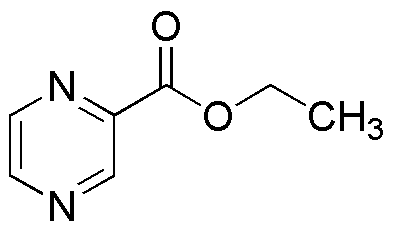2-Pyrazinecarboxylic acid ethyl ester is widely utilized in research focused on:
- Pharmaceutical Development: This compound serves as an intermediate in the synthesis of various pharmaceuticals, particularly in creating anti-inflammatory and antimicrobial agents.
- Agricultural Chemicals: It is used in the formulation of agrochemicals, enhancing the efficacy of pesticides and herbicides, which helps in improving crop yields.
- Flavoring Agents: The compound is employed in the food industry as a flavoring agent, contributing to the development of unique taste profiles in various products.
- Material Science: It is utilized in the production of polymers and resins, providing improved durability and resistance to environmental factors.
- Research Applications: In academic and industrial research, it is used as a building block for synthesizing complex organic molecules, facilitating advancements in organic chemistry.
General Information
Properties
Safety and Regulations
Applications
2-Pyrazinecarboxylic acid ethyl ester is widely utilized in research focused on:
- Pharmaceutical Development: This compound serves as an intermediate in the synthesis of various pharmaceuticals, particularly in creating anti-inflammatory and antimicrobial agents.
- Agricultural Chemicals: It is used in the formulation of agrochemicals, enhancing the efficacy of pesticides and herbicides, which helps in improving crop yields.
- Flavoring Agents: The compound is employed in the food industry as a flavoring agent, contributing to the development of unique taste profiles in various products.
- Material Science: It is utilized in the production of polymers and resins, providing improved durability and resistance to environmental factors.
- Research Applications: In academic and industrial research, it is used as a building block for synthesizing complex organic molecules, facilitating advancements in organic chemistry.
Documents
Safety Data Sheets (SDS)
The SDS provides comprehensive safety information on handling, storage, and disposal of the product.
Product Specification (PS)
The PS provides a comprehensive breakdown of the product’s properties, including chemical composition, physical state, purity, and storage requirements. It also details acceptable quality ranges and the product's intended applications.
Certificates of Analysis (COA)
Search for Certificates of Analysis (COA) by entering the products Lot Number. Lot and Batch Numbers can be found on a product’s label following the words ‘Lot’ or ‘Batch’.
Numéro de catalogue
Numéro de lot/série
Certificates Of Origin (COO)
This COO confirms the country where the product was manufactured, and also details the materials and components used in it and whether it is derived from natural, synthetic, or other specific sources. This certificate may be required for customs, trade, and regulatory compliance.
Numéro de catalogue
Numéro de lot/série
Safety Data Sheets (SDS)
The SDS provides comprehensive safety information on handling, storage, and disposal of the product.
DownloadProduct Specification (PS)
The PS provides a comprehensive breakdown of the product’s properties, including chemical composition, physical state, purity, and storage requirements. It also details acceptable quality ranges and the product's intended applications.
DownloadCertificates of Analysis (COA)
Search for Certificates of Analysis (COA) by entering the products Lot Number. Lot and Batch Numbers can be found on a product’s label following the words ‘Lot’ or ‘Batch’.
Numéro de catalogue
Numéro de lot/série
Certificates Of Origin (COO)
This COO confirms the country where the product was manufactured, and also details the materials and components used in it and whether it is derived from natural, synthetic, or other specific sources. This certificate may be required for customs, trade, and regulatory compliance.


